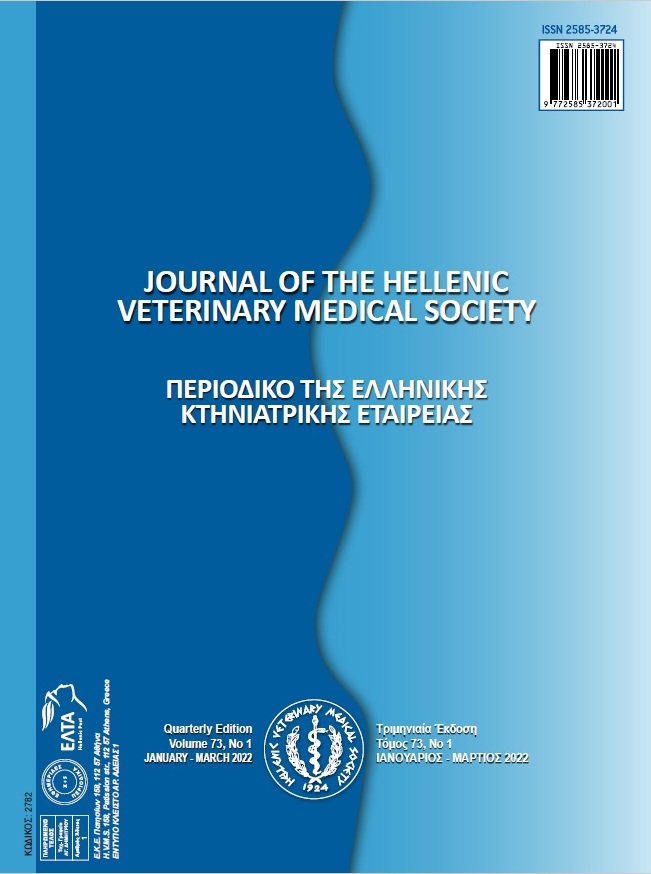Postoperative pain assessment with concurrent administration of intraperitoneal tramadol and incisional lidocaine following ovariohysterectomy in dogs
Περίληψη
This study aimed to assess postoperative pain with concurrent administration of intraperitoneal tramadol and incisional lidocaine following ovariohysterectomy in dogs. A group of twenty mixed breed female dogs, aged 1–2 years, weighing 19.5 ± 0.8 kg were used. Initially, dogs were sedated with intramuscular administration of acepromazine 1%. Anaesthesia was induced with diazepam (0.5 mg/kg) and ketamine (10 mg/kg) and maintained with 1.5% Isoflurane. Ketoprofen (2 mg/kg) was administered intravenously immediately before surgery. Five minutes before midline incision, saline (0.2 ml/kg) was administered to the muscles and subcutaneous space around the incision in the tramadol-saline (TS) group. Also, in the tramadol-lidocaine (TL) group, lidocaine 2% with epinephrine (1.5 mg/Kg) was administered. Ovariohysterectomy was performed and before closing the linea alba, tramadol (4 mg/kg) was splashed on the abdominal viscera in both groups. Cortisol, vital signs and pain scoring systems were evaluated at different time points. Heart rate, respiratory rate and rectal temperature changes were not significant between groups. Cortisol level showed a significant difference between groups at 1, 3 and 6 hours after surgery (p≤0.05). Both UMPS and CMPS-SF pain scores in the TL group were significantly lower than the TS group at 30 minutes, 1, 3 and 6 hours after surgery (p≤0.05) and also at 12 hours after surgery (p≤0.05). It seems that intraperitoneal administration of tramadol (4 mg/kg) along with administration of incisional lidocaine with epinephrine (1.5 mg/kg) is recommended following ovariohysterectomy in dogs.
Λεπτομέρειες άρθρου
- Πώς να δημιουργήσετε Αναφορές
-
Peysokhan, M., Sabiza, S., Ronagh, A., & Razi Jalali, M. (2022). Postoperative pain assessment with concurrent administration of intraperitoneal tramadol and incisional lidocaine following ovariohysterectomy in dogs. Περιοδικό της Ελληνικής Κτηνιατρικής Εταιρείας, 73(1), 3597–3604. https://doi.org/10.12681/jhvms.24628
- Τεύχος
- Τόμ. 73 Αρ. 1 (2022)
- Ενότητα
- Research Articles

Αυτή η εργασία είναι αδειοδοτημένη υπό το CC Αναφορά Δημιουργού – Μη Εμπορική Χρήση 4.0.
Οι συγγραφείς των άρθρων που δημοσιεύονται στο περιοδικό διατηρούν τα δικαιώματα πνευματικής ιδιοκτησίας επί των άρθρων τους, δίνοντας στο περιοδικό το δικαίωμα της πρώτης δημοσίευσης.
Άρθρα που δημοσιεύονται στο περιοδικό διατίθενται με άδεια Creative Commons 4.0 Non Commercial και σύμφωνα με την άδεια μπορούν να χρησιμοποιούνται ελεύθερα, με αναφορά στο/στη συγγραφέα και στην πρώτη δημοσίευση για μη κερδοσκοπικούς σκοπούς.
Οι συγγραφείς μπορούν να καταθέσουν το άρθρο σε ιδρυματικό ή άλλο αποθετήριο ή/και να το δημοσιεύσουν σε άλλη έκδοση, με υποχρεωτική την αναφορά πρώτης δημοσίευσης στο J Hellenic Vet Med Soc
Οι συγγραφείς ενθαρρύνονται να καταθέσουν σε αποθετήριο ή να δημοσιεύσουν την εργασία τους στο διαδίκτυο πριν ή κατά τη διαδικασία υποβολής και αξιολόγησής της.



